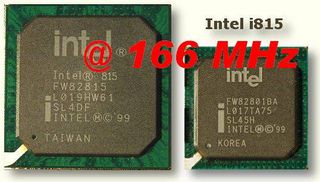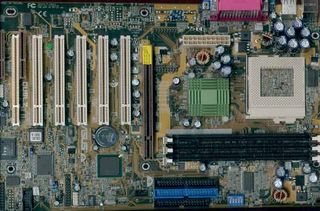Leading by Speeding: Solano at 166 MHz
Introduction
BX Outclocked: Solano Shows Its Potential

The most significant characteristic of high performance computers is a fast system speed. This external clock speed (currently 133 MHz) is crucial for best overall performance still today. Some months ago, we had a VIA 694X and a Intel 440BX platform running at 150 MHz system speed and circumstanciated the performance gains thanks to the higher memory bandwidth. The results clearly indicate that raising the system speed is often more effective than obtaining a faster clocked processor.
Naturally I wanted to determine the performance benefit at 166 MHz Front Side Bus. So far there is no 815-166 (see picture). However, modern motherboards like the Asus CUSL2 support several clock speeds beyond the specified 133 MHz.
Maybe you are disappointed to hear that speeds faster than 166 MHz are not really possible today. Even with highest quality memory modules it is virtually impossible to run the system bus at any higher clock speed.
Demands: AGP
In contrast to the aged BX chipset, Intel's 815 has been designed for 133 MHz operation. As a result it comprehends all dividers in order to run the AGP within the specs (66 MHz). Remember that both the PCI and the AGP clock are derivated from the system clock speed. As the BX is approved for 100 MHz max, it only knows the dividers 1/1 and 2/3 (for 66 resp. 100 MHz FSB). Overclocked to 133 MHz, the AGP will run at 89 MHz - too much for many graphics cards!
This issue it even more critical at 150 MHz system speed: In this case, your graphics card has to endure 100 MHz (!) AGP speed, which is merely tolerated by GeForce models so far.
The Solano does not suffer from such problems, as the AGP speed does "only" reach 83 MHz even at 166 MHz system clock speed (divider 1/2). According to our experience, this is no problem for the majority of today's AGP graphics cards.
Demands: PCI And On-Board Components
The whole thing is a bit touchier for PCI components, as the bus will be running at 42 MHz. Timing critical add-on cards like SCSI or network controllers will easily be affected by high overclocking, thus you can almost be sure of running into trouble.
Stay on the Cutting Edge
Join the experts who read Tom's Hardware for the inside track on enthusiast PC tech news — and have for over 25 years. We'll send breaking news and in-depth reviews of CPUs, GPUs, AI, maker hardware and more straight to your inbox.
For performance freaks, there is only one way of solving this: Get rid of any hardware which you do not require. That will reduce the number of PCI cards to one or two (sound card and modem/network).
If you depend on specific components, I would stop thinking about 166 MHz FSB right now. The following hardware can cause problems:
- SCSI adapters
- IDE-RAID controllers
- 100Base-TX- or ATM network adapters
- Firewire controllers
- High end audio devices
- Any exotic hardware
Demands: The CPU
Every Pentium III will work reliable at 166 MHz as long as the core clock does not reach lunatic speeds. Using a 166 MHz setup, a Pentium III 650/100 would have to run at 1083 MHz, for example. You certainly do not need to have visionary power to realize that there's no point of even trying it.
It's best to use a 133 MHz model for overclocking to 166 (Pentium III 600EB, 667, 733, 800EB, etc). The next table discerns between realistic setups and desperate configurations:
| CPU | Specs | Core speedat 166 MHz FSB | Chance of success | Core voltage |
|---|---|---|---|---|
| Pentium III 550E | 100 x 5.5 | 916 MHz | Little | 1.75 - 1.8 V |
| Pentium III 600E | 100 x 6 | 1000 MHz | Hardly any | 1.75 - 1.85 V |
| Pentium III 600 EB | 133 x 4.5 | 750 MHz | Excellent | 1.65 - 1.75 V |
| Pentium III 650 | 100 x 6.5 | 1083 MHz | No chance | - |
| Pentium III 667 | 133 x 5 | 833 MHz | Good | 1.65 - 1.75 V |
| Pentium III 700 | 100 x 7 | 1166 MHz | No chance | - |
| Pentium III 733 | 133 x 5.5 | 916 MHz | Good | 1.7 - 1.8 V |
| Pentium III 750 | 100 x 7.5 | 1250 MHz | No chance | - |
| Pentium III 800 E | 100 x 8 | 1333 MHz | No chance | - |
| Pentium III 800 EB | 133 x 6 | 1000 MHz | Fair | 1.75 - 1.85 V |
| Pentium III 850 | 100 x 8.5 | 1416 MHz | No chance | - |
| Pentium III 866 | 133 x 6.5 | 1083 MHz | Hardly any | 1.75 - 1.9 V |
| Pentium III 933 | 133 x 7 | 1166 MHz | No chance | - |
| Pentium III 1000 | 133 x 7.5 | 1250 MHz | No chance | - |
Demands: SDRAM

Though most PC133 SDRAM modules run stable at this clock speed, they usually cannot be operated at a CAS latency of 2 clock cycles. Many types have to be run at CAS 3, which reduces the system performance by few per cent. At first sight, it does not sound much, but remember that the difference between two processor speed grades (e.g. PIII 650 and 700) is usually about the same!
We have always been using highest quality SDRAM memory from Micron/Crucial, Memory Solutions or Wichmann Workx (Germany), which can be operated at CAS 2. Even when "only" running 150 MHz you may be forced to reduce the CAS latency time from 2 to 3 clock cycles. At 166 MHz, not even one of our different memory modules runs stable at CAS 2.
Well, I think you understand what I am figuring out right now. If an average SDRAM module can only be run at 133 MHz using CAS 3, the timing would have to be increased even more at higher clock speeds, which of course is impossible. Thus forget CL3 SDRAM for this undertaking.
In order to have the system running stable, I had to reduce all SDRAM timings to the slowest options: CAS 2, RAS-to-CAS 3 and Precharge Time 3.
Asus CUSL2
I had two interesting motherboards available for this project: AOpen AX3S Pro and the Asus CUSL2. The Asus finally made it, because the AOpen board operates the main memory at only 140 MHz when running 166 MHz FSB due to some limitation of its clock generator. A comprehensive 815 motherboard round up is scheduled for the next weeks. Than we will also introduce the AX3S Pro in detail.

The CUSL2 is a typical Asus motherboard as it gives you excellent quality teamed with performance and overclocking features. Making use of the ICH2 chip, the two IDE ports are UltraATA-100 compliant. Six PCI slots, AGP 4x and the AMR slot are provided.
The system did not want to run stable at 166 MHz FSB when I installed more than one memory module. Obviously the timing is already at the limit using one module.
Most Popular

